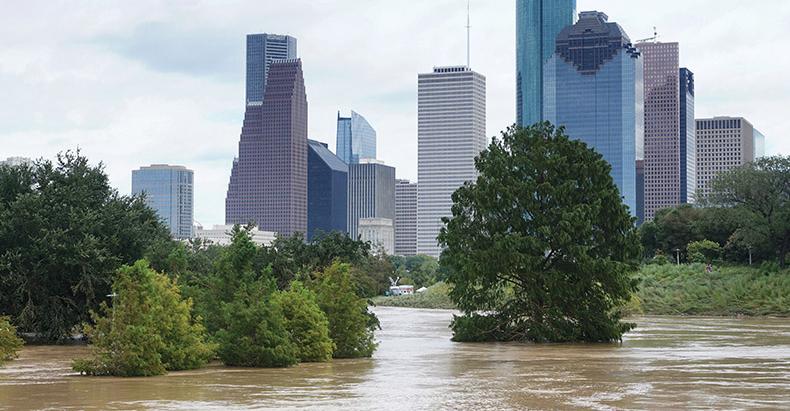Our eCampus will be offline for maintenance starting Thursday, January 1, 2026 (12:00 a.m.) and will be back online on Friday, January 2, 2026 (12:00 a.m.).

The How and Where of Climate Risk
CONTENT SPONSORED BY ESRI
In a move that could alter the practice of buying and selling homes, real estate broker Redfin is adding climate risk scores to sale listings. Home buyers can now evaluate climate risk the way they assess local schools, tax rates, and neighborhood appeal.
The new data addresses the public’s growing interest in understanding the shifting nature and location of risk. It’s a pursuit shared by business leaders, many of whom already use predictive models and analysis from geographic information system (GIS) technology to anticipate climate shifts and adjust investment strategies accordingly.

Environmental variables associated with climate change require commercial real estate professionals to model and analyze potential impacts.
Climate Risk on Buyers’ Minds
Nearly 80 percent of current and potential homeowners told Redfin they’d be hesitant to buy a home in an area with frequent or intense natural disasters. In the same survey, nearly half of people planning to move in the next year indicated that extreme temperatures and increasing natural disasters played a role in that decision.
Given the weather disruptions that have already beset many areas of the world, it’s no surprise that home buyers and businesses are considering climate risk in their investment decisions. In each of the past 40 years, the United States averaged seven weather disasters costing more than $1 billion each (adjusted for inflation). But in the past six years, the average number of $1 billion events per year increased to more than 15, according to the National Oceanic and Atmospheric Administration. These events are not just costly but devastating to homes, businesses, neighborhoods, critical infrastructure, and supply chains.
Companies have long relied on GIS-generated location intelligence to respond to weather events. Now, the technology’s ability to model long-term weather patterns and related climate risk could shape real estate investments for individuals and organizations.
Assessing Climate Risk
Climate risk data, similar to the kind Redfin now provides, is also important to commercial property investment decisions. Commercial real estate leader CBRE estimates that 35 percent of global REIT properties are exposed to hazardous climate events, such as inland flooding and hurricanes.
Even with the escalation of climate-related weather events and the persistent pandemic, commercial property sales totaled a record $809 billion in 2021. This nearly doubled the total sales of the previous year, according to data firm Real Capital Analytics. Real estate investors see this acceleration in sales remaining in 2022 as the pandemic continues to drive demand for commercial properties like warehouses and other logistics centers and apartment buildings. And while the climate risk hasn’t previously been a major factor in choosing commercial properties for investment, evidence shows it is now moving up higher on the list of concerns for real estate professionals.
A recent article from McKinsey & Company noted that building climate intelligence will become an imperative for investors who want to create value and strategic differentiation in the real estate industry. According to McKinsey, the continuing trend toward more emissions regulations, net-zero commitments, and tenants demanding more sustainable buildings will fuel the need for data that brings more visibility into climate-related risks. This type of climate intelligence will help real estate investors make more informed decisions when looking at their portfolios. Some real estate companies are already conducting climate stress tests on their portfolios to gauge whether a property’s location, carbon footprint, or tenant composition will benefit or be harmed by climate changes and decrease in value over time.
This evidence of the growing importance of factoring in climate-related data based on geography has also been noted by the Urban Land Institute (ULI). The group shared in the report “Climate Risk and Real Estate: Emerging Practices for Marketing Assessment” that real estate investors are already using climate risk data to make decisions in locations susceptible to climate change. With this data, some are determining whether to invest, or continue investing, in markets that are more vulnerable to climate impacts. But they’re not evaluating climate risk alone. They’re also factoring in resilience efforts by cities that invest in infrastructure and policy changes to reduce vulnerabilities. ULI says some real estate investors are even starting to pull out of certain markets entirely due to climate risk, another indicator of its growing importance in investment decisions.
In industries like commercial real estate, telecom, and retail — where choosing the right location is key to the bottom line — the ability to predict climate impacts on potential investments is a competitive advantage.
Environmental variables associated with climate change require commercial real estate professionals to model and analyze potential impacts.
For example, engineering, design, and project management firm Atkins uses GIS technology to perform climate modeling, drawing on the precision of GIS-produced location intelligence to steer clients toward safer investments and fortify their supply chains.
Atkins’ simulations use predictive analytics to create location intelligence on climate scenarios. The resultant GIS map shows how and where tropical storms or extreme temperatures might disrupt the flow of shipping containers across global supply lines now and in the future.
Tailoring Investments to Population Growth or Decline
As more people turn to climate risk data for guidance on where to live and work, businesses are keeping a close eye on how populations shift. The location of everything from a new retail storefront to a same-day fulfillment center to an office complex could turn on those outcomes.
Over the past 18 to 24 months, business planners have worked to understand population migrations, with varying levels of success. The COVID-19 pandemic, remote work, and climate-driven location decisions like those observed by Redfin have muddied the waters. But organizations with high levels of location intelligence have enjoyed more clarity.
They’re using GIS analysis to detect shifting sales locations, changing travel patterns, and cities and neighborhoods where populations are growing or declining.
Using Location Intelligence to Mitigate Investment Risks
Climate risks and new market transitions due to the pandemic have altered the needs of both consumers and businesses and made it even more critical to gain visibility into all elements that may affect a potential property’s present and future value. Esri technology and services help commercial real estate professionals bring together data, world-class mapping, 3D modeling, and spatial analysis to gain location intelligence for smarter investment decisions.
Commercial real estate leaders who utilize GIS-based location intelligence have the tools to weigh the consequences of climate change on a particular location or building. Moreover, they can research entire markets to learn more about broader vulnerabilities to climate-related events like the intensity and frequency of hurricanes and wildfires. This insight allows them to better manage investments at both the market and neighborhood levels.
As climate risks alter the places where people buy houses and organizations build businesses, industry leaders in commercial real estate will use that clarity to adjust their investments. Commercial real estate professionals can use location intelligence from Esri to be proactive, understanding and measuring a potential investment’s resilience to climate-related effects. By taking this geographic approach, industry pros can make fully informed decisions and formulate smarter real estate investment strategies in the future.
This content was brought to you by Esri, provider of the world's most powerful mapping and spatial analytics software. For more information, visit www.esri.com or contact Esri's business team at bizteam@esri.com.






